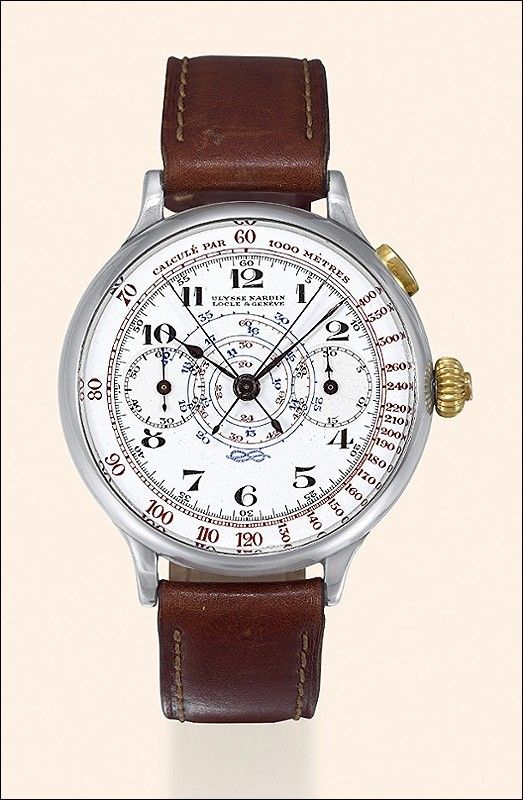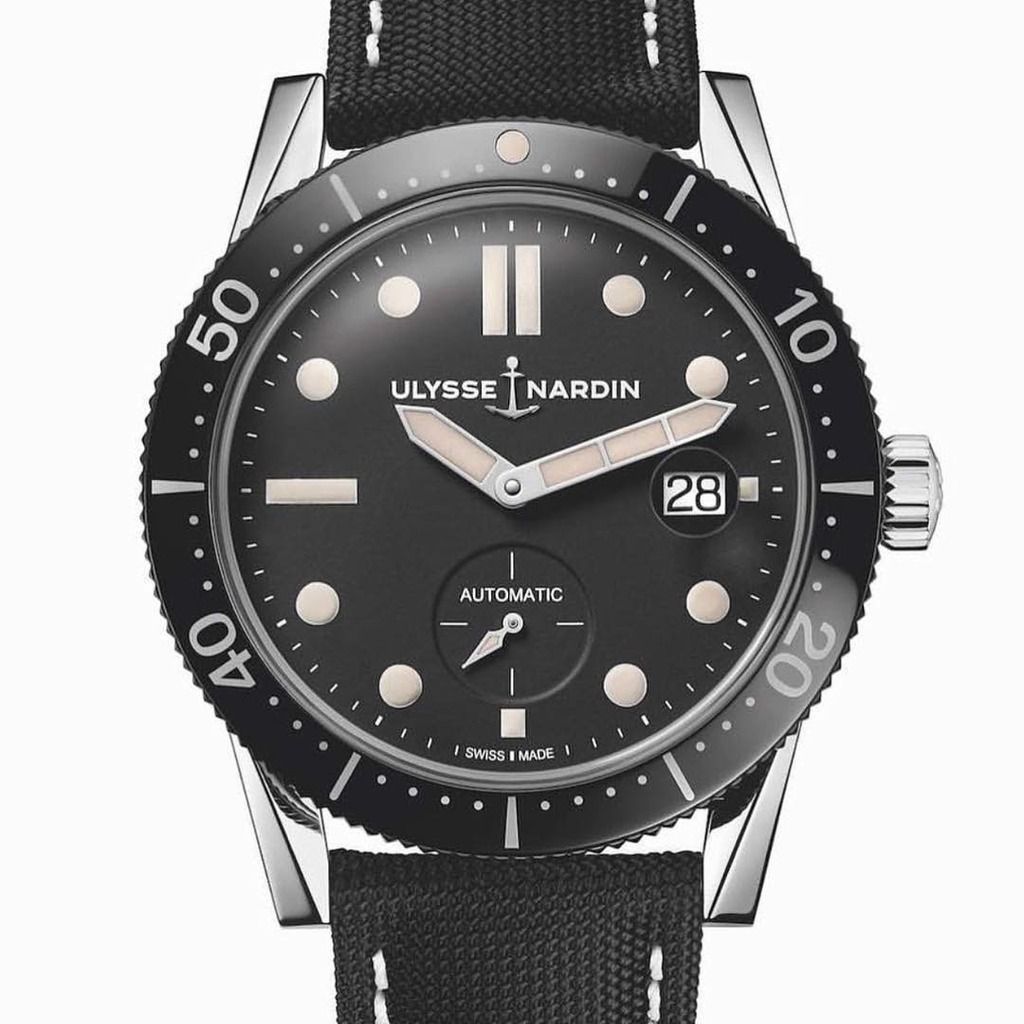Ίσως το πρώτο μοντέλο της εταιρίας που βλέπω και μου αρέσει φίλε Κώστα, πολύ ωραίο, ειδικά η κορώνα.
Ulysse Nardin
- markosgr28
- moderator
- Δημοσιεύσεις: 12388
- Εγγραφή: Πέμ Ιούλ 16, 2009 6:19 pm
- Τοποθεσία: Ηράκλειο, Κρήτης
- Has thanked: 23 times
- Been thanked: 5138 times
Re: Ulysse Nardin
- These users thanked the author markosgr28 for the post:
- Megalos (Δευ Μάιος 09, 2016 9:21 am)
- Rating: 7.69%
- nick10
- moderator
- Δημοσιεύσεις: 10658
- Εγγραφή: Παρ Ιούλ 31, 2009 5:12 pm
- Has thanked: 6390 times
- Been thanked: 10709 times
- Επικοινωνία:
Re: Ulysse Nardin
Technical Perspective A Look Toward The Future With The Ulysse Nardin Anchor Tourbillon (And Why Every Watch Nerd Needs To Know About This Watch)
When you think about how watches are made, what comes to mind? Do you think of watchmakers wearing lab coats and loupes, meticulously polishing a part before adding it to a movement? Or do you think of nanofabrication engineers in cleanrooms, precisely adjusting plasma density to etch a part from a silicon wafer? It is a bit of both with the Ulysse Nardin Anchor Tourbillon, and that is a very good thing. The use of silicon in mechanical watches is becoming more and more popular, as brands are realizing the advantages the material brings to a mechanical watch movement. Silicon is anti-magnetic, extremely hard and lightweight, requires no lubrication, and can be manufactured to a level of accuracy previously unheard of. (Think in terms of nanometers rather than microns.)
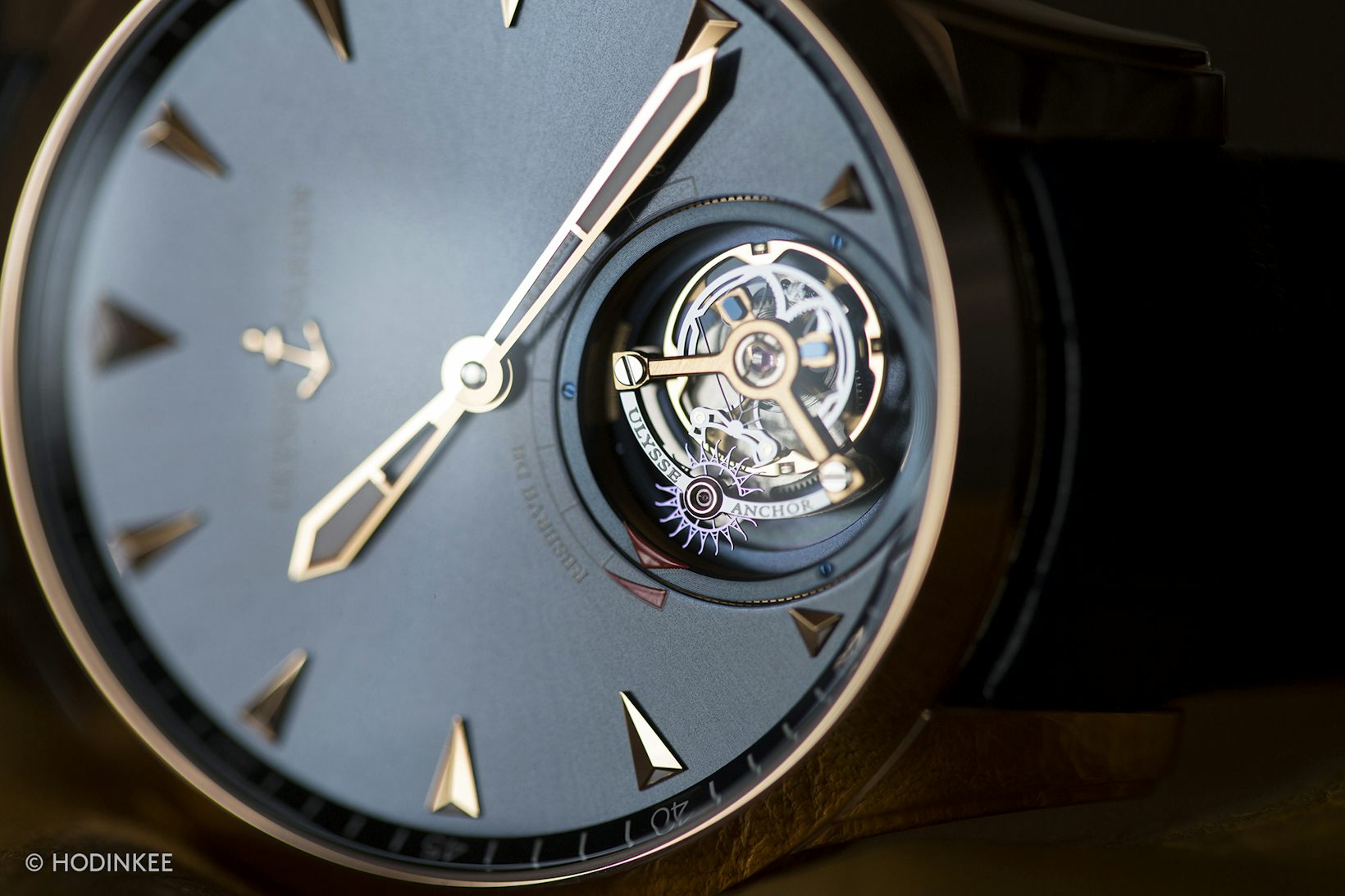
Ulysse Nardin is a pioneer in the development of silicon technology for watchmaking. In 2000, the brand introduced its Dual Direct Escapement featuring silicon escape wheels. The Anchor Tourbillon takes silicon in watchmaking a step further, by building a mechanism that would have been virtually impossible to manufacture with any other technology. This is what makes this watch so appealing – it is a massive technological exercise that took years to develop. Rather than focus on duplicating existing parts in a movement with silicon, Ulysse Nardin (along with Sigatec, which they co-own) developed something completely new that significantly improves timekeeping.

So what exactly makes the Anchor Tourbillon so intriguing? The Anchor Tourbillon features a pallet fork with no pivots. Yes, you read that right – the pallet fork is suspended in between the escape wheel and balance roller with ultra-thin silicon blades. These blades buckle back and forth, allowing the pallet fork to perform its locking, unlocking and impulsing actions without a pivot. Not having a pivot means fewer parts, and no need for lubrication. I spoke with Stéphane von Gunten, Ulysse Nardin’s Manager of Research and Development, to find out more.
HODINKEE: Where did the idea to suspend the pallet fork on blades originate from?
Stéphane von Gunten: The guidance of the classical anchor through its two pivots rotating into small jewels was always a delicate topic in the watchmaking history. The pivots are not lubricated and it can sometimes lead to material wear over the years of function of the watch. There is also a little play [gap] between the pivots and the hole of the jewel which can produce small inaccuracy in the escapement. The original idea of the Ulysse Anchor was to suspend the whole anchor on two thin blades to reach a perfect positioning system [zero gap] thanks to this virtual pivot and to avoid any risk of material wear [zero friction].
HODINKEE: How thin are the blades?
Stéphane von Gunten: The blades have a thickness of 15 micrometers and are 4 mm long. This aspect ratio is made possible only thanks to the silicon micro-machining technology of [a process called DRIE for Deep Reactive Ion Etching]. The blades are completely straight over the length of 4 mm, as the precision in the geometry is better than .5 micrometers.

HODINKEE: How are the upper pallet fork and lower pallet fork attached?
Stéphane von Gunten: The two levels are fixed together by our watchmakers with the use of two small rivets that have a diameter of about .4 mm.
HODINKEE: Why did the shape of the escape wheel teeth change from earlier versions?
Stéphane von Gunten: The [latest] version of the Ulysse Anchor Escapement is a so-called constant escapement. This particularity allows the balance wheel to get the same amount of energy, so the same amplitude, all through the discharge of the main spring. It helps to get constant frequency of oscillations in an independent manner of the torque delivered from the main spring. The energy is given from the blades and the escape wheel is now used as a “recharger” of the blades that comes after each impulse to the balance wheel. It was not the case in the first version of the Ulysse Anchor Escapement. It is for this technical reason that the geometry of the wheel has been slightly adjusted by our engineers.

HODINKEE: What do the notches on the periphery of the pallet fork bridge do? Are they to adjust tension on the blades?
Stéphane von Gunten: Exactly. These two levers are used to put the blades in compression. With the right compression the system becomes bi-stable. By switching from one stable position to the other, a small amount of energy is given to the balance wheel at each alternance [vibration].
HODINKEE: Is there any functional benefit to having different thicknesses of silicon oxide deposition on the pallet fork and escape wheel?
Stéphane von Gunten: The utility of the [silicon] dioxide layer is to have a low frictional coefficient between the wheel and the pallets. It also induces no risk of material wear [no abrasion]. A minimum thickness is required for the technical properties of the parts, mainly to have a low frictional coefficient. Depending on the part and its dimensions the aesthetics, color of the part, can be influenced by the thickness of the oxide layer [diffraction of light into the silicon dioxide layer]. Small variations of colors could also happen depending on the direction of the light to the objects.

With the all-silicon escapement in its one-minute flying tourbillon, you really have a mesmerizing mechanism. As the tourbillon rotates the silicon reflects light in a beautiful way, with different colors depending on the amount of oxide deposition for the individual parts. This watch is an exercise in both traditional and futuristic watchmaking, and the result is evidence that mechanical watches have tons of room to continue to innovate.


πηγή: https://www.hodinkee.com/articles/a-loo ... tourbillon" onclick="window.open(this.href);return false;
When you think about how watches are made, what comes to mind? Do you think of watchmakers wearing lab coats and loupes, meticulously polishing a part before adding it to a movement? Or do you think of nanofabrication engineers in cleanrooms, precisely adjusting plasma density to etch a part from a silicon wafer? It is a bit of both with the Ulysse Nardin Anchor Tourbillon, and that is a very good thing. The use of silicon in mechanical watches is becoming more and more popular, as brands are realizing the advantages the material brings to a mechanical watch movement. Silicon is anti-magnetic, extremely hard and lightweight, requires no lubrication, and can be manufactured to a level of accuracy previously unheard of. (Think in terms of nanometers rather than microns.)

Ulysse Nardin is a pioneer in the development of silicon technology for watchmaking. In 2000, the brand introduced its Dual Direct Escapement featuring silicon escape wheels. The Anchor Tourbillon takes silicon in watchmaking a step further, by building a mechanism that would have been virtually impossible to manufacture with any other technology. This is what makes this watch so appealing – it is a massive technological exercise that took years to develop. Rather than focus on duplicating existing parts in a movement with silicon, Ulysse Nardin (along with Sigatec, which they co-own) developed something completely new that significantly improves timekeeping.

So what exactly makes the Anchor Tourbillon so intriguing? The Anchor Tourbillon features a pallet fork with no pivots. Yes, you read that right – the pallet fork is suspended in between the escape wheel and balance roller with ultra-thin silicon blades. These blades buckle back and forth, allowing the pallet fork to perform its locking, unlocking and impulsing actions without a pivot. Not having a pivot means fewer parts, and no need for lubrication. I spoke with Stéphane von Gunten, Ulysse Nardin’s Manager of Research and Development, to find out more.
HODINKEE: Where did the idea to suspend the pallet fork on blades originate from?
Stéphane von Gunten: The guidance of the classical anchor through its two pivots rotating into small jewels was always a delicate topic in the watchmaking history. The pivots are not lubricated and it can sometimes lead to material wear over the years of function of the watch. There is also a little play [gap] between the pivots and the hole of the jewel which can produce small inaccuracy in the escapement. The original idea of the Ulysse Anchor was to suspend the whole anchor on two thin blades to reach a perfect positioning system [zero gap] thanks to this virtual pivot and to avoid any risk of material wear [zero friction].
HODINKEE: How thin are the blades?
Stéphane von Gunten: The blades have a thickness of 15 micrometers and are 4 mm long. This aspect ratio is made possible only thanks to the silicon micro-machining technology of [a process called DRIE for Deep Reactive Ion Etching]. The blades are completely straight over the length of 4 mm, as the precision in the geometry is better than .5 micrometers.

HODINKEE: How are the upper pallet fork and lower pallet fork attached?
Stéphane von Gunten: The two levels are fixed together by our watchmakers with the use of two small rivets that have a diameter of about .4 mm.
HODINKEE: Why did the shape of the escape wheel teeth change from earlier versions?
Stéphane von Gunten: The [latest] version of the Ulysse Anchor Escapement is a so-called constant escapement. This particularity allows the balance wheel to get the same amount of energy, so the same amplitude, all through the discharge of the main spring. It helps to get constant frequency of oscillations in an independent manner of the torque delivered from the main spring. The energy is given from the blades and the escape wheel is now used as a “recharger” of the blades that comes after each impulse to the balance wheel. It was not the case in the first version of the Ulysse Anchor Escapement. It is for this technical reason that the geometry of the wheel has been slightly adjusted by our engineers.

HODINKEE: What do the notches on the periphery of the pallet fork bridge do? Are they to adjust tension on the blades?
Stéphane von Gunten: Exactly. These two levers are used to put the blades in compression. With the right compression the system becomes bi-stable. By switching from one stable position to the other, a small amount of energy is given to the balance wheel at each alternance [vibration].
HODINKEE: Is there any functional benefit to having different thicknesses of silicon oxide deposition on the pallet fork and escape wheel?
Stéphane von Gunten: The utility of the [silicon] dioxide layer is to have a low frictional coefficient between the wheel and the pallets. It also induces no risk of material wear [no abrasion]. A minimum thickness is required for the technical properties of the parts, mainly to have a low frictional coefficient. Depending on the part and its dimensions the aesthetics, color of the part, can be influenced by the thickness of the oxide layer [diffraction of light into the silicon dioxide layer]. Small variations of colors could also happen depending on the direction of the light to the objects.

With the all-silicon escapement in its one-minute flying tourbillon, you really have a mesmerizing mechanism. As the tourbillon rotates the silicon reflects light in a beautiful way, with different colors depending on the amount of oxide deposition for the individual parts. This watch is an exercise in both traditional and futuristic watchmaking, and the result is evidence that mechanical watches have tons of room to continue to innovate.


πηγή: https://www.hodinkee.com/articles/a-loo ... tourbillon" onclick="window.open(this.href);return false;
Το watchfunclub στα μέσα κοινωνικής δικτύωσης!
Fb: https://www.facebook.com/groups/118633621493682/
Instagram: https://www.instagram.com/watchfunclub/
Το γούστο μου είναι απλό, διαλέγω πάντα το καλύτερο...

Fb: https://www.facebook.com/groups/118633621493682/
Instagram: https://www.instagram.com/watchfunclub/
Το γούστο μου είναι απλό, διαλέγω πάντα το καλύτερο...

- markosgr28
- moderator
- Δημοσιεύσεις: 12388
- Εγγραφή: Πέμ Ιούλ 16, 2009 6:19 pm
- Τοποθεσία: Ηράκλειο, Κρήτης
- Has thanked: 23 times
- Been thanked: 5138 times
- Megalos
- Διαχειριστής
- Δημοσιεύσεις: 42422
- Εγγραφή: Τετ Μάιος 13, 2009 3:05 am
- Τοποθεσία: Athens
- Has thanked: 38840 times
- Been thanked: 8426 times
Re: Ulysse Nardin
πανεμορφο εργο τεχνης θα ελεγα Μαρκο ... πολυ τεχνολογια και τεχνογνωσια απο μια εταιρεια που κατεχει την τεχνη της ωρολογοποιιας
Το watchfunclub στα μέσα κοινωνικής δικτύωσης!
Facebook: https://www.facebook.com/groups/118633621493682/
Instagram: https://www.instagram.com/watchfunclub/
Facebook: https://www.facebook.com/groups/118633621493682/
Instagram: https://www.instagram.com/watchfunclub/
- nick10
- moderator
- Δημοσιεύσεις: 10658
- Εγγραφή: Παρ Ιούλ 31, 2009 5:12 pm
- Has thanked: 6390 times
- Been thanked: 10709 times
- Επικοινωνία:
Re: Ulysse Nardin
όντως αυτό το ρολόι είναι κόσμημα, τρομερή δουλειά από την Ulysse Nardin 
 Αν δείτε στο αρχικό άρθρο, έχει ενα gif που δείχνει το escapement σε λειτουργία, τσεκάρετε το
Αν δείτε στο αρχικό άρθρο, έχει ενα gif που δείχνει το escapement σε λειτουργία, τσεκάρετε το 
- Rating: 7.69%
Το watchfunclub στα μέσα κοινωνικής δικτύωσης!
Fb: https://www.facebook.com/groups/118633621493682/
Instagram: https://www.instagram.com/watchfunclub/
Το γούστο μου είναι απλό, διαλέγω πάντα το καλύτερο...

Fb: https://www.facebook.com/groups/118633621493682/
Instagram: https://www.instagram.com/watchfunclub/
Το γούστο μου είναι απλό, διαλέγω πάντα το καλύτερο...

- Megalos
- Διαχειριστής
- Δημοσιεύσεις: 42422
- Εγγραφή: Τετ Μάιος 13, 2009 3:05 am
- Τοποθεσία: Athens
- Has thanked: 38840 times
- Been thanked: 8426 times
Re: Ulysse Nardin
- Rating: 7.69%
Το watchfunclub στα μέσα κοινωνικής δικτύωσης!
Facebook: https://www.facebook.com/groups/118633621493682/
Instagram: https://www.instagram.com/watchfunclub/
Facebook: https://www.facebook.com/groups/118633621493682/
Instagram: https://www.instagram.com/watchfunclub/
- markosgr28
- moderator
- Δημοσιεύσεις: 12388
- Εγγραφή: Πέμ Ιούλ 16, 2009 6:19 pm
- Τοποθεσία: Ηράκλειο, Κρήτης
- Has thanked: 23 times
- Been thanked: 5138 times
Re: Ulysse Nardin
Ωραίο είναι, προσωπικά μου αρέσει, αλλά δεν ξέρω γιατί θα μου ταίριαζε καλύτερα σε γυναικείο. Ίσως επειδή ροζίζει λίγο το lume.
- nick10
- moderator
- Δημοσιεύσεις: 10658
- Εγγραφή: Παρ Ιούλ 31, 2009 5:12 pm
- Has thanked: 6390 times
- Been thanked: 10709 times
- Επικοινωνία:
Re: Ulysse Nardin
Δεν είναι άσχημο
Το watchfunclub στα μέσα κοινωνικής δικτύωσης!
Fb: https://www.facebook.com/groups/118633621493682/
Instagram: https://www.instagram.com/watchfunclub/
Το γούστο μου είναι απλό, διαλέγω πάντα το καλύτερο...

Fb: https://www.facebook.com/groups/118633621493682/
Instagram: https://www.instagram.com/watchfunclub/
Το γούστο μου είναι απλό, διαλέγω πάντα το καλύτερο...

- nick10
- moderator
- Δημοσιεύσεις: 10658
- Εγγραφή: Παρ Ιούλ 31, 2009 5:12 pm
- Has thanked: 6390 times
- Been thanked: 10709 times
- Επικοινωνία:
Re: Ulysse Nardin
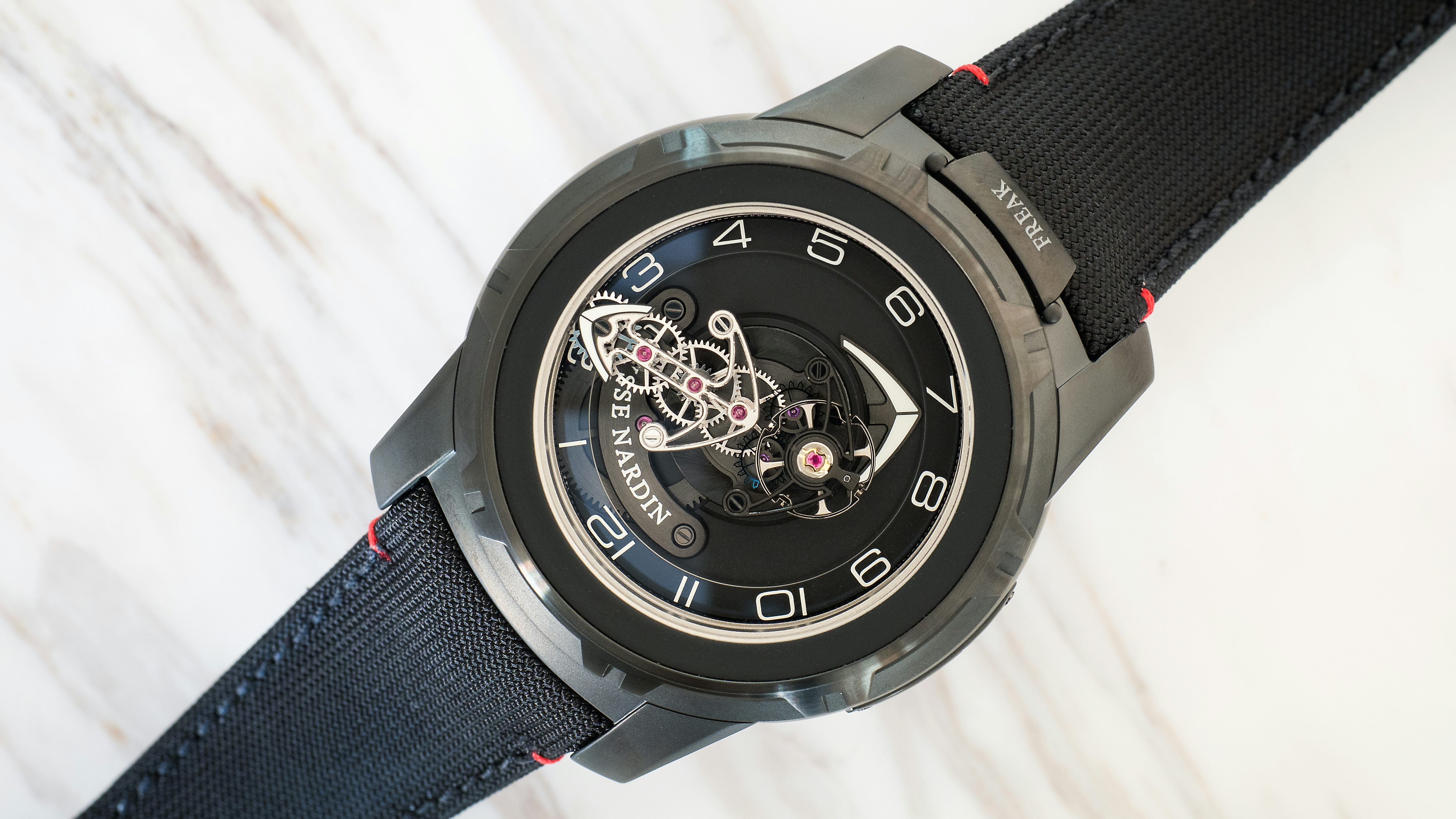
Hands-On The Ulysse Nardin Freak 'Freak Out' Full Black
The latest iteration of the design that ushered in the Age Of The Superwatch
The very first watch bash I ever attended was a memorable one – it was the launch dinner, in New York, in 2001, for the Ulysse Nardin Freak, and the watch was introduced to us all by the late Rolf Schnyder, the man who created, along with Dr. Ludwig Oechslin, the new Ulysse Nardin from the ashes of the old. By the time the first Freak was introduced, the revitalized Ulysse Nardin had already become famous thanks to its Trilogy Of Time astronomical complications, but the Freak was something decidedly different: a massive, gold, carrousel-tourbillon wristwatch in which the minute hand was also the entire movement (minus mainspring and gearing for the hour hand) and which, on top of everything else, was also the very first wristwatch anywhere, from anyone, to use silicon components.
To say the original Freak made a strong impression on watch enthusiasts of nearly two decades ago, is to say nothing at all – nothing like it had ever been seen before, and it was much more than a nine day's wonder. Single-handedly, the Freak inaugurated the era of the superwatch – mechanically sophisticated, visually arresting, unapologetically exotic – and helped along by the launch of the Opus series at Harry Winston, under the direction of then-CEO Max Büsser, a very wild ride indeed began in modern watchmaking.
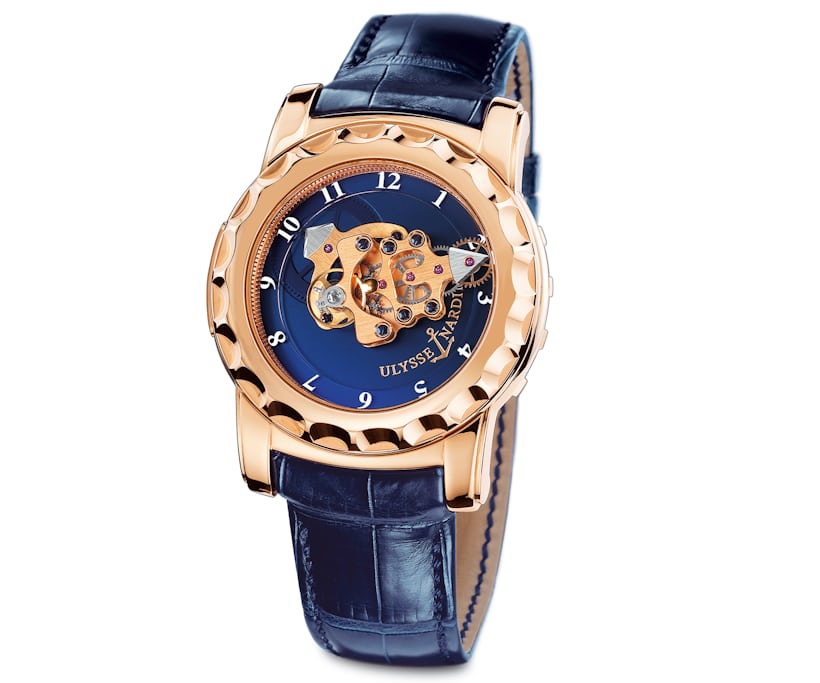
The original Ulysse Nardin Freak, 2001
The origin of the Freak was a concept created by Cartier's Carole Forestier, who in 1998 received the Prix de la Fondation Abraham-Louis Breguet for her central carousel tourbillon design. She consulted at UN for a time, but left before the design was finalized and went on to work at Renaud et Papi and Van Cleef & Arpels, before joining Cartier in 2005. (However, her fascination with such tourbillons is still clearly visible in some of her work for Cartier.) Her original design was the conceptual basis for what eventually became the Freak, and the evolution of the design involved an eventual complete reconfiguration of the original concept under the direction of Dr. Ludwig Oechslin, which, among other things, took the power reserve from 30 hours to over a week in the final watch.
The Freak went on to go through a truly bewildering number of variations, and in addition to cosmetic design changes, it has been over the years a launch platform for everything from exotic new materials, to new escapements. The basic design, however – a central carousel tourbillon, powered by an enormous mainspring that takes up the entire diameter of the case, which rotates once an hour – has proven amazingly durable over nearly two decades.

The new Ulysse Nardin 'Freak Out' in titanium and black PVD. Case, 45mm, water resistant to 30 meters.
This latest version of the Freak has the same basic architecture as the very first, and which all Freaks have shared for nearly twenty years. The heart of the Freak is the minute hand, which is also the movement, and which sits on a carriage which is driven by the gigantic mainspring that sits directly under it. As the carriage turns, the movement/minute hand mounted on it turns as well. A gear at its tip rotates against fixed teeth under the bezel, transmitting energy down the gear train to the escape wheels. The last wheel before the escape wheel gears to one of the escape wheel pinions, and as the balance locks and unlocks them (via a small lever, which like a traditional lever escapement both acts to lock the escape wheels, and transmit energy to the balance) the minute hand/movement gradually advances around the dial.

The "Dual Ulysse" escapement, with double escape wheels.
The whole system is quite interesting to watch and has few parallels in modern watchmaking even conceptually (aside from Carole Forestier's later work with Cartier). The idea of a watch where the movement rotates inside the case is not a new one and ironically, it seems to have originated in a watch designed for economy: the Waterbury Long Wind, which was designed for the lowest possible parts count, had a nine foot mainspring, and which would sell for less than half of the cheapest watches of its time (the late 1880s; one example is in the Smithsonian Institute's National Museum Of American History). Though the principle is similar, in the Long Wind pure economy of manufacture was the goal, while in the Freak, the same idea has been developed to produce a particular aesthetic.

Except for the hour hand driving gears, the entire movement is mounted on a rotating tourbillon carriage.

The main going train bridge is skeletonized, and in the shape of a stylized anchor. The movement is caliber UN-205, with a one week power reserve; flying carousel tourbillon with Dual Ulysse silicon escapement.
From an historical perspective alone, the Freak is a significant watch, but part of the reason it has become so, and a modern classic, is that its aesthetic is, while no longer completely unique, still immediately identifiable and unmistakeable. Several versions of the Freak have been produced which use exotic materials to push the limits of what's possible in watchmaking from both a design and engineering standpoint (the Freak Innovision is one; the FreakLab is another) but the Freak Out is something of a counterpoint to such watches – there is little to distract you from the purity of the design and engineering, which seem particularly unified in this watch.

The two counter-rotating silicon escape wheels of the Dual Ulysse escapement.
Silicon has largely been used for its technical advantages, rather than its aesthetic potential, in modern watchmaking, but it does have some interesting visual properties as well – depending on the light it can be quite flat and very nearly disappear, especially against a dark background but at the right angle, its surfaces flicker to life, in most eye-catching blues and violets. This is somewhat reminiscent of blued or heat-purpled steel, and it gives the depths of the Freak a fugitive light, like the body of a carp appearing and disappearing in a garden pond. It's a very striking effect and, for the technically minded enthusiast, it also means you can clearly make out the very unusual shape of the escape wheel teeth, with their stylized ocean-wave profiles – an example of engineering constraints leading necessarily to beauty. Watchmaking at its best connects the two in a way very rare in modern manufactured objects.


Operating the Freak is very straightforward. There's no crown; to set the watch, you lift up the small locking tab at the base of the bezel at 6:00. This allows you to rotate the bezel forwards or backwards, setting the hour hand and minute hand/movement. Winding the watch is done by turning the knurled bezel on the underside of the watch; you can see the extremely large mainspring (which would be comfortable doing duty in a table clock) through a small aperture in the caseback. The idiosyncratic visuals of the Freak extend to its nocturnal appearance as well, with the rather sci-fi chevrons of luminous material on the hands glowing like the wings of alien nocturnal insects.

There are some watches that are considered, more or less, must-haves, and for various reasons – if not must-haves, then at least watches you should experience on some level if you're interested in watches at all. Some members of this group are fairly self-evident: the Rolex Submariner, the Omega Speedmaster, any simple Patek Philippe, the Lange Datograph, and so on. Obviously, the basis of such a list is not ownership per se, but rather, the accumulation of the direct, personal experiences so essential to a contextually grounded enjoyment of watches and watchmaking (personally, I'd put the JLC Atmos in there as well, to say nothing of the Reverso).

For many watch enthusiasts, the Freak doesn't necessarily immediately suggest itself as a must-see classic but I think it should. In pioneering the use of silicon, the exploitation of its potential for novel mechanical and aesthetic purposes, and also for its establishment virtually single-handed of an entirely new genre of watch designs, it's worth seeking out. It's a watch that plays a serious game in just about every aspect of modern mechanical horology, and as the years and decades continue to pass, it's a watch that will, I think, continue to reward study with a kind of fascination hard to find elsewhere in watchmaking.
For a look at another historically pioneering design from Ulysse Nardin, check out our story on the Ulysse Nardin Tellurium Johannes Kepler, a groundbreaking astronomical complication from the 1990s, still in production at Ulysse Nardin. The Freak Out Full Black is $48,000 in black PVD titanium; for full specs and more info, see it at Ulysse-Nardin.com.
πηγή: https://www.hodinkee.com/articles/ulyss ... k-hands-on" onclick="window.open(this.href);return false;
- Rating: 7.69%
Το watchfunclub στα μέσα κοινωνικής δικτύωσης!
Fb: https://www.facebook.com/groups/118633621493682/
Instagram: https://www.instagram.com/watchfunclub/
Το γούστο μου είναι απλό, διαλέγω πάντα το καλύτερο...

Fb: https://www.facebook.com/groups/118633621493682/
Instagram: https://www.instagram.com/watchfunclub/
Το γούστο μου είναι απλό, διαλέγω πάντα το καλύτερο...

- markosgr28
- moderator
- Δημοσιεύσεις: 12388
- Εγγραφή: Πέμ Ιούλ 16, 2009 6:19 pm
- Τοποθεσία: Ηράκλειο, Κρήτης
- Has thanked: 23 times
- Been thanked: 5138 times


